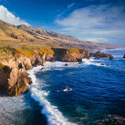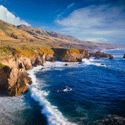Stormy seas
In the late 1960s, Benoît Mandelbrot introduced the concept of a fractal, which describes systems that are self-similar at different length or time scales. Scientists have since discovered fractal characteristics in myriad systems, such as the frequency distribution of earthquakes or the structure of rock formations. A visually appealing example is the coastline: forever changing as the sea and land interact, it shows both local and long-range patterns.
In a paper in Physical Review E, Pablo Morais, at the Federal University of Ceará in Brazil, and colleagues quantify how the geometry of the coastline, combined with the nature of the rocks that line it and the force of the sea, contribute to coastal erosion.
When the sea is calm the coastline manages to trap most of the water, and erosion is short-lived. A stormy sea causes perpetual erosion. Morais et al. find that these two regimes are separated at a critical value of the force of the sea. This value is also characterized by the fractal nature of the coastline, with a fractal dimension, which is related to how “jagged” the coastline appears in a satellite image.
The group finds a numerical estimate of how effectively a rocky coastline may be able to resist erosion, a result that could provide insight into topics such as water management, landslides, and flood prevention. – Sami Mitra





